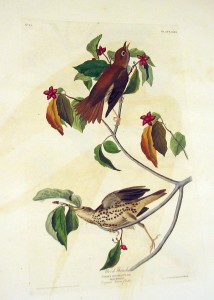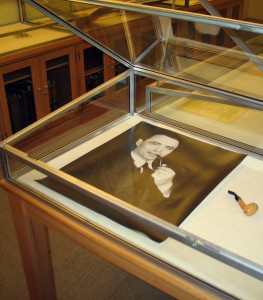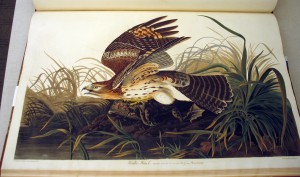 “Kind reader, you now see before you my greatest favourite of the feathered tribes of our woods. To it I owe much. How often has it revived my drooping spirits, when I have listened to its wild notes in the forest, after passing a restless night in my slender shed, so feebly secured against the violence of the storm, as to shew me the futility of my best efforts to rekindle my little fire, whose uncertain and vacillating light had gradually died away under the destructive weight of the dense torrents of rain that seemed to involve the heavens and the earth in one mass of fearful murkiness, save when the red streaks of the flashing thunderbolt burst on the dazzled eye, and, glancing along the huge trunk of the stateliest and noblest tree in my immediate neighbourhood, were instantly followed by an uproar of crackling, crashing, and deafening sounds, rolling their volumes in tumultuous eddies far and near, as if to silence the very breathings of the unformed thought!”
“Kind reader, you now see before you my greatest favourite of the feathered tribes of our woods. To it I owe much. How often has it revived my drooping spirits, when I have listened to its wild notes in the forest, after passing a restless night in my slender shed, so feebly secured against the violence of the storm, as to shew me the futility of my best efforts to rekindle my little fire, whose uncertain and vacillating light had gradually died away under the destructive weight of the dense torrents of rain that seemed to involve the heavens and the earth in one mass of fearful murkiness, save when the red streaks of the flashing thunderbolt burst on the dazzled eye, and, glancing along the huge trunk of the stateliest and noblest tree in my immediate neighbourhood, were instantly followed by an uproar of crackling, crashing, and deafening sounds, rolling their volumes in tumultuous eddies far and near, as if to silence the very breathings of the unformed thought!”
–J. J. Audubon, Ornithological Biography, I (1831), 372 [excerpted].
Comments Off on The Wood Thrush (Audubon “bird of the week”)
 “They always feed on the wing. In calm and warm weather, they soar to an immense height, pursuing the large insects called Musquito Hawks, and performing the most singular evolutions that can be conceived, using their tail with an elegance of motion peculiar to themselves. Their principal food, however, is large grasshoppers, grass-caterpillars, small snakes, lizards, and frogs. They sweep close over the fields, sometimes seeming to alight for a moment to secure a snake, and holding it fast by the neck, carry it off, and devour it in the air. When searching for grasshoppers and caterpillars, it is not difficult to approach them under cover of a fence or tree. When one is then killed and falls to the ground, the whole flock comes over the dead bird, as if intent upon carrying it off. An excellent opportunity is thus afforded of shooting as many as may be wanted, and I have killed several of these Hawks in this manner, firing as fast as I could load my gun.”
“They always feed on the wing. In calm and warm weather, they soar to an immense height, pursuing the large insects called Musquito Hawks, and performing the most singular evolutions that can be conceived, using their tail with an elegance of motion peculiar to themselves. Their principal food, however, is large grasshoppers, grass-caterpillars, small snakes, lizards, and frogs. They sweep close over the fields, sometimes seeming to alight for a moment to secure a snake, and holding it fast by the neck, carry it off, and devour it in the air. When searching for grasshoppers and caterpillars, it is not difficult to approach them under cover of a fence or tree. When one is then killed and falls to the ground, the whole flock comes over the dead bird, as if intent upon carrying it off. An excellent opportunity is thus afforded of shooting as many as may be wanted, and I have killed several of these Hawks in this manner, firing as fast as I could load my gun.”
–J. J. Audubon, Ornithological Biography, I (1831), 369 [excerpted].
Comments Off on The Swallow-tailed Hawk (Audubon “bird of the week”)
 Our April/May exhibition will focus on the life and career of Trinity alumnus Hyam Plutzik ’32, who studied under Trinity professor Odell Shepard (1884-1967). During his student years, Plutzik served as an editor on the Tripod, and helped revive the student yearbook, the Trinity Tablet, which had been dormant for many years. Several years after graduation, he returned to Connecticut to spend a “Thoreauvian” year in the countryside, undoubtedly inspired by Professor Shepard’s interest in the nineteenth-century Transcendentalists. In 1941, on the eve of America’s entry into World War II, Plutzik wrote a detailed account of his life since graduation in a remarkable 72-page letter to Odell Shepard, the original of which is in the Watkinson, and will be on display. It was Odell Shepard who wrote Plutzik’s recommendation letter to Yale University, where he pursued graduate work on scholarship from Trinity College
Our April/May exhibition will focus on the life and career of Trinity alumnus Hyam Plutzik ’32, who studied under Trinity professor Odell Shepard (1884-1967). During his student years, Plutzik served as an editor on the Tripod, and helped revive the student yearbook, the Trinity Tablet, which had been dormant for many years. Several years after graduation, he returned to Connecticut to spend a “Thoreauvian” year in the countryside, undoubtedly inspired by Professor Shepard’s interest in the nineteenth-century Transcendentalists. In 1941, on the eve of America’s entry into World War II, Plutzik wrote a detailed account of his life since graduation in a remarkable 72-page letter to Odell Shepard, the original of which is in the Watkinson, and will be on display. It was Odell Shepard who wrote Plutzik’s recommendation letter to Yale University, where he pursued graduate work on scholarship from Trinity College
Most of the materials on display are on loan from the University of Rochester, which hosts the Plutzik Reading Series, one of the longest-running reading series in the country.
 The opening of the exhibition (which is being installed as I write) will be on April 9, from 1:30 – 3:30pm, and will feature readings of Plutzik’s work by our own award-winning poet Ciaran Berry, Artist-in-Residence Clare Rossini, and Dick Allen, the Poet Laureate of Connecticut. Trinity students will also read selections of their own poetry.
The opening of the exhibition (which is being installed as I write) will be on April 9, from 1:30 – 3:30pm, and will feature readings of Plutzik’s work by our own award-winning poet Ciaran Berry, Artist-in-Residence Clare Rossini, and Dick Allen, the Poet Laureate of Connecticut. Trinity students will also read selections of their own poetry.
Comments Off on Hyam Plutzik ’32, American Poet
 “Every species of bird is possessed of a certain, not always definable, cast of countenance, peculiar to itself. Although it undergoes changes necessary for marking the passions of the individual, its joy, its anger, its terror or despondency, still it remains the same specific look. Hawks are perhaps more characteristically marked in this manner than birds of any other genus, being by nature intended for deeds of daring enterprise, and requiring a greater perfection of sight to enable them to distinguish their prey at great distances. To most persons the family-look of particular species does not appear so striking as to the student of nature, who examines her productions in the haunts which she has allotted to them. He perceives at a glance the differences of species, and when he has once bent his attention to an object, can distinguish it at distances which to the ordinary observer present merely a moving object, whether beast or bird. When years of constant observation have elapsed, it becomes a pleasure to him to establish the differences that he has found to exist among the various species of a tribe, and to display to others whose opportunities have been more limited the fruits of his research.”
“Every species of bird is possessed of a certain, not always definable, cast of countenance, peculiar to itself. Although it undergoes changes necessary for marking the passions of the individual, its joy, its anger, its terror or despondency, still it remains the same specific look. Hawks are perhaps more characteristically marked in this manner than birds of any other genus, being by nature intended for deeds of daring enterprise, and requiring a greater perfection of sight to enable them to distinguish their prey at great distances. To most persons the family-look of particular species does not appear so striking as to the student of nature, who examines her productions in the haunts which she has allotted to them. He perceives at a glance the differences of species, and when he has once bent his attention to an object, can distinguish it at distances which to the ordinary observer present merely a moving object, whether beast or bird. When years of constant observation have elapsed, it becomes a pleasure to him to establish the differences that he has found to exist among the various species of a tribe, and to display to others whose opportunities have been more limited the fruits of his research.”
–J. J. Audubon, Ornithological Biography, I (1831), 364 [excerpted].
Comments Off on The Winter Hawk (Audubon “bird of the week”)
 “They always feed on the wing. In calm and warm weather, they soar to an immense height, pursuing the large insects called Musquito Hawks, and performing the most singular evolutions that can be conceived, using their tail with an elegance of motion peculiar to themselves. Their principal food, however, is large grasshoppers, grass-caterpillars, small snakes, lizards, and frogs. They sweep close over the fields, sometimes seeming to alight for a moment to secure a snake, and holding it fast by the neck, carry it off, and devour it in the air. When searching for grasshoppers and caterpillars, it is not difficult to approach them under cover of a fence or tree. When one is then killed and falls to the ground, the whole flock comes over the dead bird, as if intent upon carrying it off. An excellent opportunity is thus afforded of shooting as many as may be wanted, and I have killed several of these Hawks in this manner, firing as fast as I could load my gun.”
“They always feed on the wing. In calm and warm weather, they soar to an immense height, pursuing the large insects called Musquito Hawks, and performing the most singular evolutions that can be conceived, using their tail with an elegance of motion peculiar to themselves. Their principal food, however, is large grasshoppers, grass-caterpillars, small snakes, lizards, and frogs. They sweep close over the fields, sometimes seeming to alight for a moment to secure a snake, and holding it fast by the neck, carry it off, and devour it in the air. When searching for grasshoppers and caterpillars, it is not difficult to approach them under cover of a fence or tree. When one is then killed and falls to the ground, the whole flock comes over the dead bird, as if intent upon carrying it off. An excellent opportunity is thus afforded of shooting as many as may be wanted, and I have killed several of these Hawks in this manner, firing as fast as I could load my gun.”


